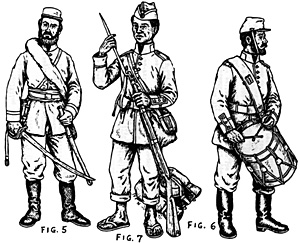Imperial Brazilian Uniforms
During the
War of the Triple Alliance
Part 1: Line Infantry
By C. A. Norman
| |
FUSILIEROS
Fig.5. Captain, Campaign Dress, c. 1866-70: Kepi in white cover. In place of the regulation tunic he wears a plain dark blue campaign coat (apparently a common practice) distinguished only by the gilt buttons and rank lace circling the cuffs. His lightish brown trousers are probably part of an other ranks working uniform, this uniform not being authorized for officers. Black gaiters and boots, white leather waistbelt and sabre knot, crimson waistsash, sabre with gilded hilt and steel scabbard. Some sort of container (possibly a water bottle) is carried in a brown cover, slung over the left shoulder. Fig.6. Fusilier Drumer, Campaign, c. l866-70: kepi with white cotton cover and white chin-strap. Dark blue tunic with dark blue collar, shoulder straps, cuffs and cuff-flaps, all edged with red piping, red collar patches and piping down the front opening, brass buttons. White duck trousers tucked into black marching boots. White belts and straps; brass belt plate, sliding bars for attachment of the pack support straps and drum stick carriers on the drum belt. Brass drum with red hoops and white tightener coeds. Pre-war, musicians ofen wore elaborately laced uniforms; all this extra gaud was abolished in 1866 to reduce battlefield visibility and they normally wore the same uniform as the rest of their unit. This particular uniform combination, with the woolen tunic and white trousers and kepi cover, seems to have been particularly prevalent as a combat dress during the war. Fig.7. Fusilier Anspessada, Campaign, c.1866-70: Dark blue barracks cap with yellow turn-up and tassel (this cap is curious as fusilieros should normally have worn caps with red trim and a red 5-point star on the front of the turn-up; possibly this might be a Cacadores cap, or simply a non-standard variant?). Tunic and trousers of light brown duck, the tunic with red collar patches and piping in the same pattern worn on the woolen tunic; the light brown duck trousers would sometimes carry side piping as well, though the white duck trousers seem to have seldom, if ever, done so. The tunic buttons are dipicted (almost invariably) as a darkish brownish tone: might they have been bronzed, or of some non-standard material such as wood or horn, or are they simply tarnished brass? Red diagonal rank stripe on the lower left sleeve. White waistbelt and cap pouch to the right of the beltplate. The white breast-strap with the brush and needle is worn hanging loose, ready for instant use. Crown sandals. On the left hip hangs a haversack of light brown duck and a canteen or water bottle of natural wood strapped with iron on a white strap. Lying on the ground behind is his black leather pack with white straps, an iron mess tin strapped to the rear flap and dark blue greatcoat in a horseshoe roll. Illustrations
Figures 5 - 7: Two Fusiliers, Capt. Figures 8 - 11: Two Cacadores, Col., Ensign Figures 12 -14: Three Cacadores on campaign Back to Brazilian Uniforms Part 1 Back to Table of Contents -- El Dorado Vol VII No. 1 © Copyright 1996 by The South and Central Military Historians Society This article appears in MagWeb (Magazine Web) on the Internet World Wide Web. |